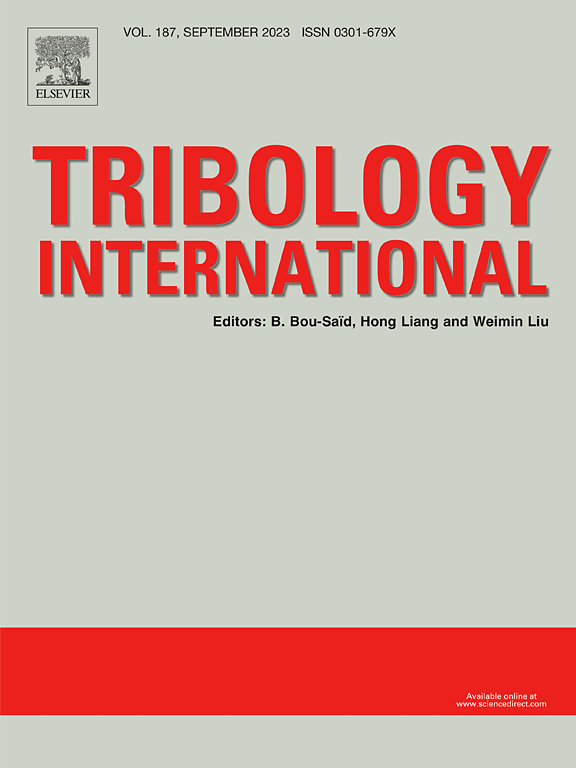Synergistic effects of laser texturing and solid lubricants in Cr3C2-NiCr-(B2O3/Bi2O3) composite coating for enhanced tribological properties at 25 °C and 800 °C
IF 6.1
1区 工程技术
Q1 ENGINEERING, MECHANICAL
引用次数: 0
Abstract
Cermet-based coatings exhibit excellent high-temperature wear resistance. However, their high-temperature lubrication performance is insufficient, which is likely to cause the friction pair materials to be severely worn. Herein, a novel Cr₃C₂-NiCr-(B₂O₃/Bi₂O₃) composite coating was developed by thermal spraying, laser texturing and high-temperature vacuum impregnation composite processes. Its tribological properties, elemental migration and synergistic lubrication mechanism were systematically investigated. The results show that the average friction coefficients of the composite coating are 0.17 and 0.08 at 25 ℃ and 800 ℃, respectively, representing reduction of 79 % and 83 % compared to the Cr₃C₂-NiCr coating, and exhibits excellent self-lubricating performance. Through in-depth analysis, a synergistic lubrication mechanism based on the migration of B/Bi elements is proposed: At elevated temperatures, B₂O₃ optimizes the friction interface as a low-viscosity glassy phase, while Bi₂O₃ reduces the shear strength via molten lubrication and the formation of Bi nanocrystalline films. B₂O₃/B₂O₃ composite lubricant provide excellent fluid lubrication at tribological interface. The mechanism originates from the dynamic coupling of low melting point migration, interfacial reaction and gradient film formation. B element enhances the interfacial bonding and thermal stability of the film through oxygen vacancy migration, while Bi element forms a plastic lubrication film via reduction and grain boundary segregation. The composite coating integrates long-term lubrication and anti-wear properties at high temperatures. These findings provide an innovative solution for the service life extension design of high-temperature moving components.
激光织构和固体润滑剂对Cr3C2-NiCr-(B2O3/Bi2O3)复合涂层25℃和800℃摩擦性能的协同作用
陶瓷基涂层具有优异的高温耐磨性。但其高温润滑性能不足,容易造成摩擦副材料的严重磨损。采用热喷涂、激光变形和高温真空浸渍复合工艺,研制了一种新型Cr₃C₂- nicr -(B₂O₃/Bi₂O₃)复合涂层。系统地研究了其摩擦学性能、元素迁移和协同润滑机理。结果表明:复合涂层在25℃和800℃时的平均摩擦系数分别为0.17和0.08,比Cr₃C₂-NiCr涂层分别降低了79 %和83 %,具有良好的自润滑性能。通过深入分析,提出了一种基于B/Bi元素迁移的协同润滑机制:在高温下,B₂O₃作为低粘度玻璃相优化摩擦界面,而Bi₂O₃通过熔融润滑和Bi纳米晶膜的形成降低抗剪切强度。B₂O₃/B₂O₃复合润滑剂在摩擦界面处提供优异的流体润滑。其机理源于低熔点迁移、界面反应和梯度成膜的动态耦合。B元素通过氧空位迁移增强膜的界面结合和热稳定性,Bi元素通过还原和晶界偏析形成塑性润滑膜。复合涂层在高温下具有长期润滑和抗磨性能。这些发现为高温运动部件的使用寿命延长设计提供了一种创新的解决方案。
本文章由计算机程序翻译,如有差异,请以英文原文为准。
求助全文
约1分钟内获得全文
求助全文
来源期刊

Tribology International
工程技术-工程:机械
CiteScore
10.10
自引率
16.10%
发文量
627
审稿时长
35 days
期刊介绍:
Tribology is the science of rubbing surfaces and contributes to every facet of our everyday life, from live cell friction to engine lubrication and seismology. As such tribology is truly multidisciplinary and this extraordinary breadth of scientific interest is reflected in the scope of Tribology International.
Tribology International seeks to publish original research papers of the highest scientific quality to provide an archival resource for scientists from all backgrounds. Written contributions are invited reporting experimental and modelling studies both in established areas of tribology and emerging fields. Scientific topics include the physics or chemistry of tribo-surfaces, bio-tribology, surface engineering and materials, contact mechanics, nano-tribology, lubricants and hydrodynamic lubrication.
 求助内容:
求助内容: 应助结果提醒方式:
应助结果提醒方式:


